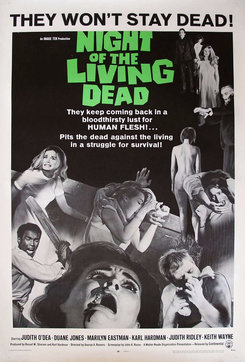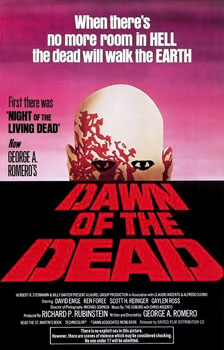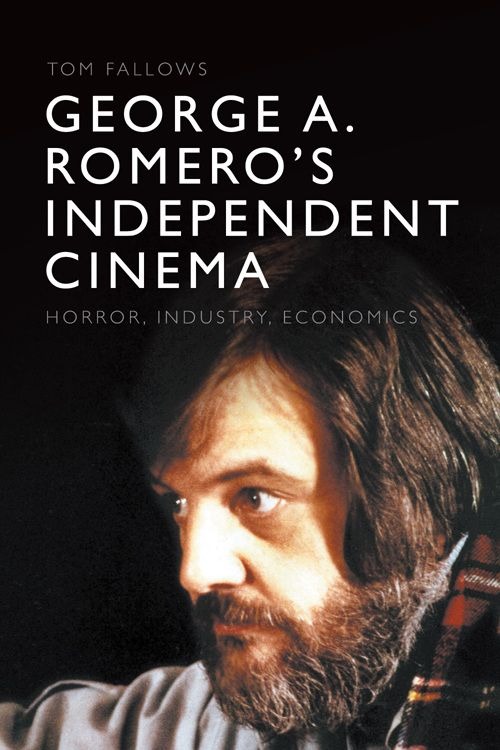Zombies and capitalism: George A. Romero's anti-capitalist critique, and his democratic, collaborative film-making
Interview Transcript
BG: Victor Halperin's movie ‘White Zombie’ from 1932, Jacques Tourneur’s ‘I Walked with a Zombie’ from 1943, Gordon Douglas' ‘Zombies on Broadway’ from 1945 … all early warning signs which were ignored by the great and the good alike until …
[‘Night of the Living Dead’ audio clip]
TF: Hi Brett, my name is Tom Fallows. I work for the American Film Institute and I'm the author of ‘George A. Romero’s Independent Cinema: Horror, Industry, Economics’ published by Edinburgh University Press.
BG: Welcome, Tom. So, born in the Bronx in New York in 1940, who was George A. Romero?
TF: George Romero is an American independent filmmaker best known for his series of zombie films which spanned from 1968 to 2009. Beginning with ‘Night of the Living Dead’ Romero and his collaborators essentially invented the modern idea of the zombie.
BG: What do you mean by ‘the modern idea of the zombie’?
TF: Traditionally, zombies had their roots in Haitian folklore, where they were basically dead bodies bought back to life as slaves through magic. Romero removed this magical component and reimagined the zombie as a mindless ghoul hungry for human flesh. In the process he also transformed them into something more immediate. He embedded his creation into the heart of America, where for US audiences they were no longer some kind of existential other: they were deceased friends, neighbours and family members.
BG: Romero's ‘Night of the Living Dead’ in 1968 was much more than a horror film, wasn't it?
TF: ‘Night …’ was famous for being one of the first US films to have an African-American hero where his race is never mentioned. Romero insists that lead actor Dwayne Jones was only cast because he was the best actor among his friends, but race is crucial to the film. Jones's hero ‘Ben’ is fiercely intelligent and capable and ends up hiding from the zombie hordes in a farmhouse where he's trapped with a white patriarchal father who undercuts Ben's agency at every turn, and the film ends in kind of the starkest way possible with Ben surviving the zombies but killed by a white posse that had supposedly come to the rescue.

[‘Night of the Living Dead’ audio clip]
TF: As other critics have pointed out, the images in this black and white horror film were evocative of a harrowing real world violence at the time where bloody attacks and assassinations on civil rights leaders and protesters frequently played out in the streets and on the evening news. In that sense there are moments in ‘Night …’ with its gritty low-budget aesthetic that feel almost like a documentary, and demonstrated Romero, whether he admitted it then or not, as a socially conscious counterculture filmmaker with his finger on the pulse of what was going on in America.
BG: So how would you describe Romero's view on people, on humanity?
TF: A main theme of his film is really communities, and how people interact with each other. When its dystopic, such as in his zombie films, it's about the impossibility for humans to function collaboratively, and how this failure often results in our destruction. The human survivors of the zombie apocalypse can never work together, and this failure ultimately leads to catastrophe. This is a thread that I think is very, very current in 2024.
BG: People not helping one another during difficult times, motivated only by self-interest? I'm … I'm … shocked! So what role does Romero's use of explicit imagery play in all this? You know – the violence, the gore, the consumption of self-centred human beings?
TF: The key aesthetic in Romero's films is obviously the violence. It's the gore: his films often revel in scenes of carnage and zombies devouring human flesh in extreme close-up. While the violence in these films has been controversial, often resulting in X ratings or getting the films banned, it never feels gratuitous, it's never violence for violence’s sake. To me the gore is crucial to Romero's politics: it gives an edge to the satire, it presents his rhetoric as something fierce and exceptionally angry and urgent. In that way these films are almost like the best punk music in that they are confrontational, anarchic and disdainful of the status quo.
BG: You mentioned ‘these films’. Tell us a little about his follow-up feature ‘Dawn of the Dead’.
TF: So after ‘Night’s …’ critique of race and racism, the sequel ‘Dawn of the Dead’ in 1978 turned to issues of consumerism in a very pointed manner. It's set in a shopping mall where it's almost impossible to see the difference between the zombies and contemporary American shoppers. ‘They are us!’ is a key line in the film and a key line in Romero's zombie cinema. The survivors in ‘Dawn …’ meanwhile use the mall as a refuge and the comfort they get from its wares allows them to ignore what's happening in the outside world. Again, this is an overt plainly-stated satire on the direction Romero felt America was headed in the 1970s. Ultimately, the film's not about consumerist greed as some critics have stated, but it's about ignoring the problems we collectively face as a society.

[‘Dawn of the Dead’ audio clip]
BG: Now, what I find very interesting is that not only were ‘Night of the Living Dead’ and ‘Dawn of the Dead’ both shot in Pittsburgh, Romero's production company, Laurel Entertainment, was also situated in Pittsburgh, rather than, say, Hollywood.
TF: Pittsburgh was crucial. As an independent filmmaker it gave him the freedom to tell the stories that he wanted to tell, largely without the interference of Hollywood or corporate decision-making. To begin with he was working with low budgets and drawing upon the local business community for financing which really allowed him to fly under the radar and produce the kinds of bold, politically radical films that we've been talking about. It also gave him space to experiment with alternative working practices and, at the start of his career, his films were much more collaborative or egalitarian than traditional modes of filmmaking allow. Romero and collaborators, such as John Russo and Russ Streiner, were really striving for a democratic process of filmmaking. ‘Night of the Living Dead’ particularly was made in this uniquely collaborative style where, although Romero was credited as the director, all the key decision-making was done collectively by a core team – from editing to shot selection to production design to core aspects of the screenplay.
BG: It sounds like a socialist, cinematic utopia. What could have possibly gone wrong?
TF: Although it started as a grassroots organisation, the international success of ‘Dawn of the Dead’ – which earned over $55 million at the box office – really changed the shape of their operations. After ‘Dawn of the Dead’ the firm went public and it became beholden to shareholders and committee meetings, just the kind of bureaucracy that Romero tried to avoid and that ultimately pushed him away from the company in the mid-1980s.
BG: Capitalism crushes creative collaboration – Stop the Press! This said however, Romero, Laurel Entertainment and their horde of zombies actually did bring some genuine prosperity to Pittsburgh in more ways than one, didn't they?
TF: Although this experiment in egalitarian film production didn't last, Romero always valued the creative input of collaborators, and his company nurtured a base of film workers that ultimately helped transform Pittsburgh more widely. This base of trained professionals fed into Pittsburgh and transformed it into a leading film centre. It remains a leading film centre to this day with Hollywood productions such as ‘The Dark Knight Rises’ using that talent base in Pittsburgh to create these big-budget films.
BG: And, of course, Romero's cinematic influence spread much farther than Pennsylvania.
TF: In terms of Romero's impact on independent cinema more widely, this can be seen most evidently in horror. ‘Night of the Living Dead’ awakened filmmakers such as Toby Hooper with ‘The Texas Chainsaw Massacre’ and Wes Craven with ‘Last House on the Left’ to not only the socio-political potential of the genre but also its affordability, demonstrating filmmaking as something that could be achieved outside of Hollywood, and even outside of New York, without compromising on their artistic vision or political ideology. ‘Halloween’ director, John Carpenter, famously once said if any independent filmmaker tells you that they weren't influenced by Romero and ‘Night of the Living Dead’, they're lying.
BG: And what about the young pretenders who have followed in his wake? Sprightly socialist transgressives, or lethargic capitalist copycats?
TF: Romero’s idea of the zombie has become dominant and it’s something we now see in everything from the AMC TV show, ‘The Walking Dead’, to Zac Snyder’s recent Netflix film, ‘Army of the Dead’. But what these recent films and TV shows tends to leave out is, as you say, the transgressive political address that has defined Romero's critical reputation.
BG: Finally, George A. Romero died in 2017. How will you remember him, Tom?
TF: Romero ended his career in Toronto, once again producing low-budget zombie films that were at once fiercely critical of American capitalism and deeply humanist in their approach to characters. I think the best thing that you can say about Romero is that he was always true to his countercultural roots and never stopped believing in the prospect of something better for America.
BG: Great to have had you on the show, man. Many thanks for your time and your insights.
TF: Thanks, Brett, it's been a pleasure to talk to you.
BG: This has been the UK Desk for Arts Express with Dr. Tom Fallows, author of ‘George A. Romero’s Independent Cinema: Horror, Industry, Economics’ which is available now via the Edinburgh University Press website. Cheers!

